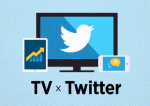
Nielsen is set to publish its first report with TV rankings based on data from Twitter. The report, which comes out on Monday according to the Wall Street Journal, will look at the number of tweets about a show and the size of the audience that sees them.
This is an important move for Twitter ahead of its IPO because it sees TV-related data as an important part of its monetization plans. Providing data about TV viewer engagement is also a key part of Twitter’s rivalry with Facebook, which has been trying to distract from the Nielsen-Twitter partnership by presenting itself as an alternative source of potentially valuable information to networks. Facebook announced last month that it will begin sending a weekly report to major broadcasters in the U.S. detailing user activity around TV programs on the social network. Now Facebook plans to extend its reach by providing data to TV shows from 10 networks in eight countries, says a report in the Wall Street Journal.
As Sarah Perez pointed out, however, despite having 1.15 billion monthly active users compared to Twitter’s 200 million, Facebook’s looser definition of active engagement might make its data difficult for networks to analyze. In this particular competition, Twitter is currently ahead of Facebook with its Nielsen partnership, TV Ad Targeting programs, tools like Twitter Amplify, which allows broadcasters to embed short video clips in tweets in near real-time and an experimental feature that will allow users to playback TV-related tweets when they watch a show after it originally aired. One potential drawback for Twitter, however, is that its user base may be too small to convince network executives of its data validity.
No matter who ultimately wins the battle to become the preferred “second screen” app of viewers, Twitter and Facebook’s efforts to provide data to broadcasters is a boon for TV fans because it helps boost shows that have a relatively small audience, but deep cultural impact and engaged audience. This may convince TV networks to spend more advertising dollars reaching the younger audiences that use Twitter and also influence their thinking when it comes to deciding which shows to renew or cancel. Users who are engaged enough while watching the show to talk about it online means they may also be paying more attention to ads aired during their favorite TV shows. (Just imagine if “My So-Called Life,” “Arrested Development” or “Veronica Mars,” all shows with fervent followers but low small viewer numbers, had been able to benefit from online chatter about them).

